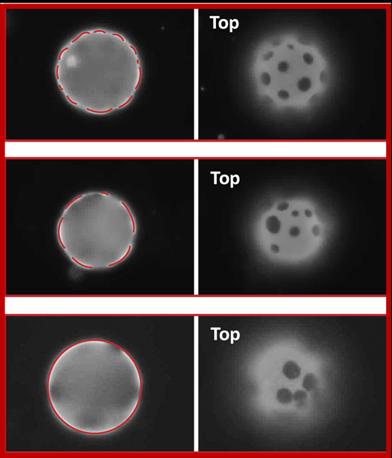Research is a leap forward in the quest for flexible ultrathin materials

Credit: Weiyue Xin of Santore lab.
AMHERST, Mass. – A team of polymer science and engineering researchers at the University of Massachusetts Amherst has demonstrated for the first time that the positions of tiny, flat, solid objects integrated in nanometrically thin membranes – resembling those of biological cells – can be controlled by mechanically varying the elastic forces in the membrane itself. This research milestone is a significant step toward the goal of creating ultrathin flexible materials that self-organize and respond immediately to mechanical force.
The team has discovered that rigid solid plates in biomimetic fluid membranes experience interactions that are qualitatively different from those of biological components in cell membranes. In cell membranes, fluid domains or adherent viruses experience either attractions or repulsions, but not both, says Weiyue Xin, lead author of the paper detailing the research, which recently appeared in Science Advances. But in order to precisely position solid objects in a membrane, both attractive and repulsive forces must be available, adds Maria Santore, a professor of polymer science and engineering at UMass. In the Santore Lab at UMass, Xin used giant unilamellar vesicles, or GUVs, which are cell-like membrane sacks, to probe the interactions between solid objects in a thin, sheet-like material. Like biological cells, GUVs have fluid membranes and form a nearly spherical shape. Xin modified the GUVs so that the membranes included tiny, solid, stiff plate-like masses. The team, a collaboration between the Santore lab and the Grason theory group in UMass’s polymer science and engineering department, is the first to show that by modifying the curvature and tension of the membrane, the plate-like masses could be made to attract and repel each other. This allowed the researchers to control the plates’ positions within the membrane.
The membrane tension can be adjusted mechanically, using a micropipette to inflate or deflate the GUV, or physically, by osmosis. In either case when the membrane is tensed, the flat plates attract each other progressively, forming predictable, repeatable arrangements. By contrast, decreasing the tension causes the plates to migrate apart. In both cases the movement and positioning of the plates is predictable and controllable.
This ability to direct the positioning of the plates in a membrane is a giant step toward engineering a material that is responsive to stimuli and can self-organize in controllable and reconfigurable ways. “Our research has applications in nanotechnology and other spheres where it’s desirable to have sophisticated, flexible devices that can respond to their environment,” says Xin. One real-world application of the team’s research includes flexible, ultrathin, and reconfigurable, wearable electronics.
###
This research was supported by a grant from the U.S. Department of Energy. Additionally, Xin received partial support from a National Institutes of Health Trainee Fellowship.
Contacts:
Maria Santore,
[email protected]
Daegan Miller,
[email protected]
Media Contact
Daegan Miller
[email protected]
Original Source
https:/
Related Journal Article
http://dx.




